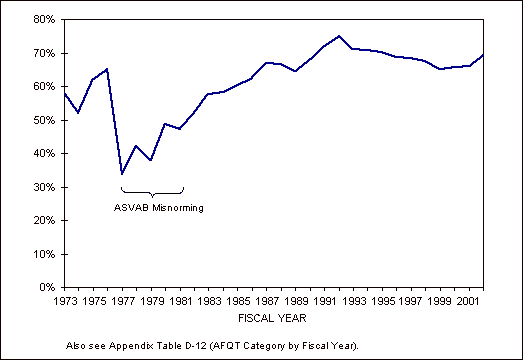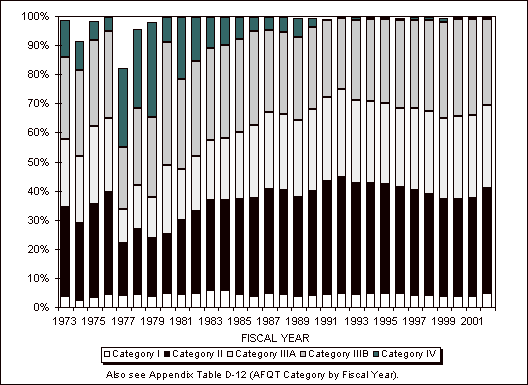


 |
 |
 |
|
AFQT AFQT scores are the primary measure of recruit potential. Figure 2.7 indicates the percentage of NPS recruits who scored at or above the 50th percentile (Categories I–IIIA) since FY 1973. Numerical data are in Appendix D, Table D-12. The drop in Category I–IIIA recruits after FY 1976 was due primarily to the miscalibration of the ASVAB.[footnote 35] In FY 1976, when new versions of the ASVAB were introduced, an error in calibrating the score scales made the new versions "easier" than the old versions (i.e., applicants received test scores higher than their actual ability). In FY 1980, an independent study of the calibration was made and the test was correctly calibrated. Then, Congress added legal provisions stipulating that no more than 20 percent of accessions could be in Category IV and that such accessions had to be high school diploma graduates.[footnote 36] However, as previously stated, Defense Department guidance decreases this limit even further, allowing no more than 4 percent of recruits to come from Category IV. Figure 2.7 shows FY 1977 as the low point and FY 1992 as the high point in accessing recruits in Categories I to IIIA. In FY 1977, 34 percent of accessions scored in the top half of the AFQT distribution. Only 13 percent of Blacks, 19 percent of Hispanics, and 20 percent of "Others" scored in Categories I–IIIA.[footnote 37] Fifteen years later, in FY 1992, most minority accessions achieved scores in the I–IIIA range (Blacks - 56 percent, Hispanics - 67 percent, "Others" - 67 percent). Hispanics have shown the most marked increase, with a 48-percentage-point gain in Category I to IIIA accessions from FY 1977 to FY 1992.  Figure 2.7. Percentage of NPS accessions in AFQT categories I–IIIA, FYs 1973–2002. A graphic view of the increasing trend in AFQT performance of accessions from FY 1973 through FY 1992 is provided in Figure 2.8. The more significant gains were in Categories I to IIIA, where the percentages increased from 47 percent in FY 1981 to 75 percent in FY 1992. Conversely, there has been a decline in the percentage of Category IIIB accessions. Most dramatic has been the decrease in accessions who score in Category IV—from 33 percent in FY 1979 to one percent or less since FY 1991. There was a gradual decline in the percentage of accessions in Categories I to IIIA from FY 1992 to FY 1999, from 75 to 65 percent. During FY 2002, recruit quality increased slightly to 69 percent in Categories I-IIIA.  Figure 2.8. Percentage of NPS accessions in AFQT categories I–IV, FYs 1973–2002. The percentages of FY 2002 active duty NPS accessions in each AFQT category are shown in Table 2.8. The percentage of recruits in Categories I and II was slightly higher than their civilian counterparts (males - 42 percent; females - 36 percent). Category III accessions greatly exceeded civilian proportions (males - 57 versus 30 percent; females - 67 versus 37 percent), while the percentage of recruits in Category IV was much lower than in the civilian population (males - 1 percent versus 20 percent; females - 1 percent versus 22 percent). The low percentage of Category IV recruits is, in part, a result of DoD limits of 4 percent Category IV recruits, with even lower Service limits. Ten percent of civilian males and 9 percent of civilian females scored in Category V; DoD allows no Category V recruits. In FY 2002, 69 percent of recruits scored at or above the 50th percentile on the AFQT (Categories I–IIIA). Air Force recruits scored higher than those of the other three Services. Seventy-five percent of Air Force recruits scored in Categories I–IIIA, compared to 70 percent of Army, 67 percent of Marine Corps, and 65 percent of Navy recruits.
[Footnote 35] See
two documents: Sims, W.H. and Truss, A.R., A Reexamination of the
Normalization of Armed Services Vocational Aptitude Battery (ASVAB) Forms
6, 7, 6E, and 7E (Alexandria, VA: Center for Naval Analyses, September
1980); and Laurence, J.H. and Ramsberger, P.F., Low-Aptitude Men in
the Military: Who Profits, Who Pays? (New York: Praeger, 1991). [back
to paragraph]
|
||||||||||||||||||||||||||||||||||||||||||||||||||||||||||||||||||||||||||||||||||||||||||||||||||||||||||||||||||
|
|